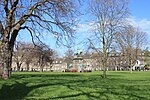Bute House

Bute House (Gaelic: Taigh Bhòid) is the official residence of the First Minister of Scotland located within Charlotte Square in Edinburgh. Alongside two other personal offices at the Scottish Parliament Building and St. Andrew's House, Bute House also contains a smaller office used by the First Minister when in official residence.Located at 6 Charlotte Square in the New Town, it is the central house on the north side of the square, and was designed by Robert Adam. Bute House was conveyed to the National Trust for Scotland by the Marquess of Bute in 1966. Between 1970 and 1999 it served as the official residence of the Secretary of State for Scotland. Since July 1999, it has been the official residence of the First Minister.The four-storey house contains the Cabinet Room, offices and conference, reception, sitting and dining rooms where the First Minister works, and where Scottish Government ministers, official visitors and guests are received and entertained. The second and third floors contain the private residence of the First Minister. As well as serving as the official residence of the First Minister, Bute House is frequently used by the First Minister to hold press conferences, media briefings, meetings of the cabinet of the Scottish Government and appointing members to the Scottish Cabinet.
Excerpt from the Wikipedia article Bute House (License: CC BY-SA 3.0, Authors, Images).Bute House
Charlotte Square, City of Edinburgh New Town
Geographical coordinates (GPS) Address Nearby Places Show on map
Geographical coordinates (GPS)
| Latitude | Longitude |
|---|---|
| N 55.9526 ° | E -3.20806 ° |
Address
Bute House
Charlotte Square 6
EH2 4DR City of Edinburgh, New Town
Scotland, United Kingdom
Open on Google Maps











